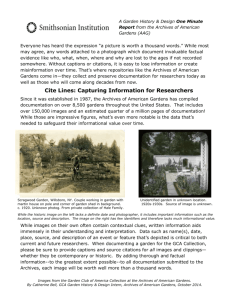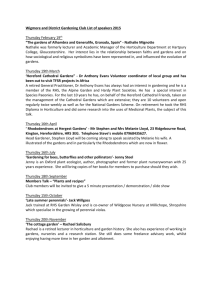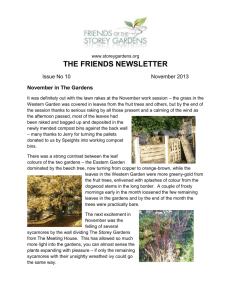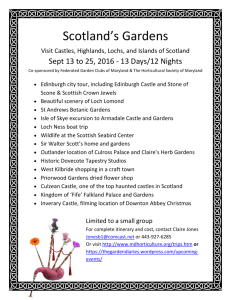From Decorative to Edible Plants - The Tour
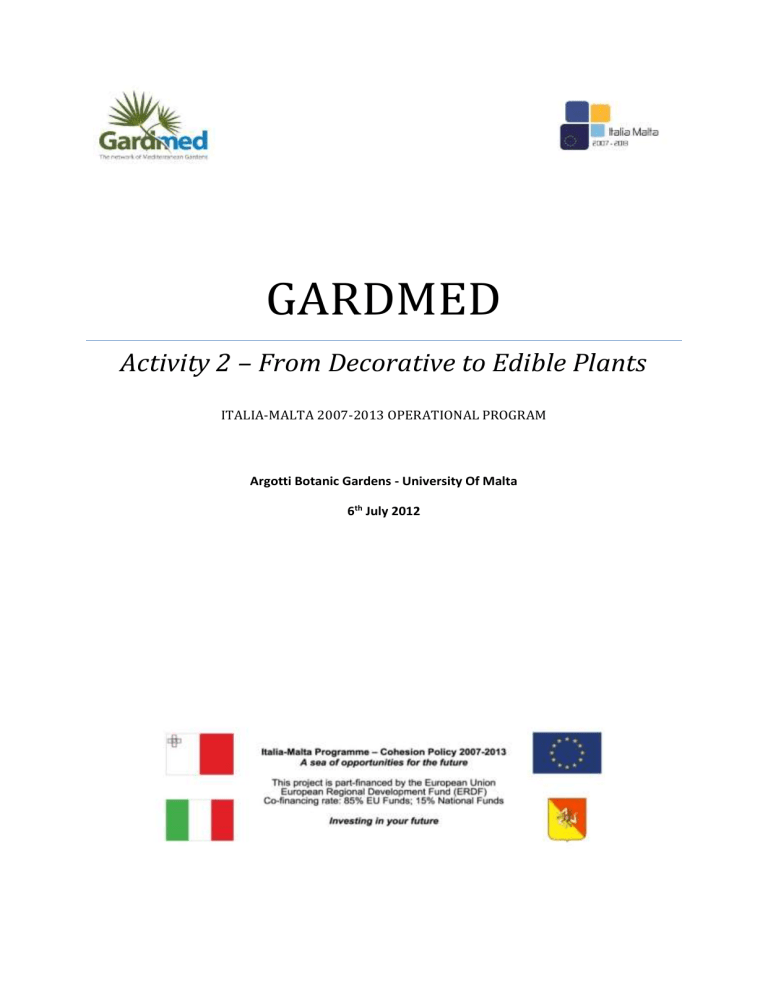
GARDMED
Activity 2 – From Decorative to Edible Plants
ITALIA-MALTA 2007-2013 OPERATIONAL PROGRAM
Argotti Botanic Gardens - University Of Malta
6 th July 2012
GARDMED – Activity 2 Report
From Decorative to Edible Plants
GARDMED under Italia-Malta 2007-2013 Operational Programme aims to conserve the natural and cultural patrimony as well as highlight and promote garden assets through the establishment of a network of Mediterranean gardens currently incorporating gardens from
Malta and Sicily. GARDMED is funded by the European Regional Development Fund and has four partners: University of Catania, Argotti Botanical Gardens (University of Malta), Floriana Local
Council and the Municipality of Syracuse.
Brief Overview
The general public has been invited to take part in five (5) themed activities to be held at Argotti
Botanical Gardens and other participating gardens as part of the GARDMED project under Italia-
Malta 2007-2013. The participating gardens are: Villa Bologna, Palazzo Parisio, Luqa Briffa (Tal-
Kmand) Garden Żejtun and The President’s Kitchen Garden.
The second activity, with the theme ‘From Decorative to Edible Plants’ was held on 6 th July 2012 at Argotti Botanic Gardens (University of Malta Section) in Floriana. Guided tours and hands-on were held between 9am and 12pm.
Advertisement
The activities were advertised in both Maltese and English in various local newspapers respectively (The Sunday Times, il-Mument, it-Torċa) on 24 June 2012. The artworks for the adverts are found in Annexe I attached. The adverts were also uploaded on GARDMED Facebook page ( https://www.facebook.com/#!/pages/Gardmed/258102884261818 ). The latter adverts also directed the general public to a link with further information. This may be found in Annexe
II
Further to the adverts, a newspaper article was also published on 24 June 2012 in The Sunday
Times. The newspaper article emphasized the main aims of the project and while it also promoted the activities organized as part of GARDMED project (Kindly refer to Annexe III)
Signage
Adequate signs, including a roll up and plaque were made for the events.
Figure 1 - The roll up banner at the entrance of Argotti Botanic Gardens in Floriana
Figure 2 - The plaque at the entrance of Argotti Botanic Gardens - University of Malta Section
From Decorative to Edible Plants - The Tour
The tour ‘From Decorative to Edible Plants’ showed plants which are commonly found in households. Seven different stations were present around the garden, each with different themes; the first station contained a selection of fruits and vegetables and the differences between the former and the latter was explained. Station two explained the purpose and techniques (Bil-feles u bil-Għajn) of grafting using different root stocks for different fruit trees.
The subsequent station underlined the differences between herbs and spices followed by a review of different spices and their origin. Following this, station 4 showed some of the aromatic herbs and explained their use in the kitchen. The next station was held in the citrus garden at Argotti and guides showed the participants the different types of citrus trees as well their use to make jams and marmalades. In connection with this, the penultimate station showed the different types of fruit preservation which exists. Participants were also given recipes on how to preserve food (kindly refer to Annexe IV b.). Lastly, a demonstration on how to plant and take care of vegetable seeds and plantlets was made while also showing different kinds of fruit trees (mango, pineapple and avocado). Attendees had the opportunity to learn about different kinds of soils in which vegetables and fruit can grow. The latter also highlighted the differences in soil properties and locations of what are commonly called ‘rabgħa bagħali’ and ‘rabgħa saqwi’. Participants had to occasion to learn how to make a good composition of different types of soil using pots having the GARDMED logo attached. Attendees were also given a bag of seeds (vegetable or herb seeds). Further details on the tour content may be found in
Annexe IV a.
Figure 3 - (Left) the bag of seeds given to attendees. (Right) pots used for planting which were also given to the participants.
Figure 4 - Station 1 Fruits and Vegetables Figure 5 - Station 2 Different rootstocks used in grafting
Figure 6 - Station 6 Preservation of Fruit and Vegetables
Figure 7 - The guide explaining food preservation
Figure 9 The plantlets planted in GARDMED pots during the activity and seed packets given during the activity
Figure 8 - Station 3 Spices
Participation
Most of the attendees present also participated in the first event organized on 28th June 2012.
They were very enthusiastic about the current and future activities to be held as part of
GARDMED. For Activity 2, 19 persons pre-booked the tour but other walk-ins also joined during the day. The ages of participants varied from children to pensioners.
a.
Artwork
Annexe I
b.
Newspaper Advert Scans
Annexe II
Further Information Page
GARDMED – Exploring Garden Treasures
GARDMED project under Italia-Malta 2007-2013 Operational Programme, aims to promote and conserve the natural and cultural heritage and highlight garden assets through the establishment of a network of Mediterranean gardens currently incorporating gardens from
Malta and Sicily. GARDMED is funded by the European Regional Development Fund and has four partners: University of Catania, Argotti Botanical Gardens (University of Malta), Floriana Local
Council and the Municipality of Syracuse.
The general public is invited to take part in five (5) themed activities to be held at Argotti
Botanical Gardens and other participating gardens as part of the GARDMED project under Italia-
Malta 2007-2013. The participating gardens are: Villa Bologna, Palazzo Parisio, Luqa Briffa (Tal-
Kmand) Garden Żejtun and The President’s Kitchen Garden. Further information on the garden which will be open on the day of the activity will be communicated prior to the event.
These activities will include guided tours consisting of hands-on activities in the garden. The garden events are scheduled for the following dates: 28 th June, 6 th July, 3 rd and 16 th August and
7 th September 2012.
Activity Number
1
2
3
4
5 7
3
28
16 th
6 rd th th th
Date
June 2012
July 2012
August 2012
August 2012
September 2012
Title of Activity
Fascination of Plants
From Decorative to Edible Plants
Garden Treasures
Sustainable Use of Garden Resources
Garden and Nature
All the tours and activities are free of charge, however due to the limited places available, interested participants should book prior to the event. Group bookings for school children or other entities are also accepted.
For further information contact Argotti Botanic Gardens (University of Malta Section), Vincenzo
Bugeja Street, Floriana on 21248984 between 8:00am and 12:00pm or email: argottigardens@um.edu.mt
Annexe III
UNIVERSITY OF MALTA
Press release
GARDMED – The Network of Mediterranean Gardens
GARDMED is a project funded by the European Regional Development Fund under
Italia-Malta 2007-2013 Operational Programme which intends to create a network of
Mediterranean gardens. The partners currently include the Catania Botanic Gardens
(University of Catania), Argotti Botanical Gardens (University of Malta), the
Municipality of Syracuse and the Floriana Local Council. The GARDMED network will involve fifteen public and private gardens in Malta and the Southern provinces of
Sicily with the aim to promote and conserve the cultural and natural heritage associated with historical Mediterranean gardens.
One of the many objectives of the project is to educate the general public on the natural heritage found in the gardens. To this end, a ten-day gardening course commenced on 6 th of June 2012 focusing on both theoretical and practical aspects.
The course has received a good response with over 20 participants. In addition to the gardening course, garden-related activities are also being organized at Argotti
Botanic Gardens (University of Malta) in Floriana.
The garden-related events will be held at Argotti and other participating gardens during the summer months from the end of June until the beginning of September
2012. The five activities, which will consist of tours and hands-on activities in the garden, will centre on the following themes: Fascination of Plants , Decorative Plants,
Flowers and Food from your Garden , Garden Treasures, Sustainable Use of Garden
Resources and Garden and Nature.
The general public is being invited to attend these open days organized as part of the GARDMED project at Argotti Botanic Gardens (University of Malta) in Floriana, which are free of charge.
Entrance for the activities will be on the hour between
9:00am and 12:00pm. Further information about GARDMED and dates for the activities may be obtained by contacting Argotti Botanic Gardens (University of Malta
Section), Vincenzo Bugeja Street, Floriana on 21248984 between 8:00am and
12:00pm, email argottigardens@um.edu.mt
or by accessing the link on the
University Of Malta website: www.um.edu.mt/argotti/activitiesen
Communications & Alumni Relations Office
20 June, 2012
Annexe IV
a.
From Decorative to Edible Plants – Tour highlights
i.
Differences between Fruits and Vegetables o Vegetables – leafy green, stem, root or flower stock of an edible plants e.g.
Carrot (Roots) o Fruit, the ovary (which may be swollen) of a plant and contains seeds. It is produced after the plant has been fertilized. ii.
Grafting o Different methods of grafting - Bil-feles u bil-Għajn o What are plant root stocks – normally are the wild variety of a plant.
o Different root stock for different plants o Quince, Bitter orange (tal-bakkaljaw), Bitter almond, wild fig and white mulberry. o Importance of timing when grafting o Taking care of the plant / tree after grafting iii.
Spices o Differences between spices and aromatic herbs o Showing of different spices and their origin o Examples: Cinnamon, aniseed curry, fennel, nutmeg, ginger etc. iv.
Aromatic Herbs o What are herbs and their properties o Their use in the kitchen
v.
Citrus Fruit o Different types of citrus fruit e.g. lemon, lime, grapefruit, orange and their different varieties. o The use of citrus fruit – juice, marmalade, jams etc. vi.
Preservation of Fruit o Drying, Salting, Freezing, Candying, Pickling, o Making Syrups and Beverages from fruit. o Showing of different jams, marmalades and preserved food. vii.
Planting of vegetables and their care o Planting of small plants, re potting and sowing seeds. o Taking care of vegetable plants and importance of timing during sowing. o Different types of soils and making best soil composition for different kinds of vegetabls. o Different kinds of field soils - Properties and locations of what are commonly called ‘rabgħa bagħali’ and ‘rabgħa saqwi’.
b.
Preservation of food recipes
Strawberry Jam
Ingredients
5 cups strawberries
7 cups sugar
1 box powdered pectin
To prepare fruit
Sort and wash fully ripe strawberries, remove stems and Crush
Method
1.
Wash half-point home canning jars in warm, soapy water and sterilize by boiling for 10 minutes. Keep hot until filled.
2.
Pre-treat two-peace vacuum seal canning lids according to package directions to ensure a good seal.
3.
Pack solidly the fruit selected in a cup and put the fruit in a kettle.
4.
Stir the powdered pectin into prepared fruit. Add ¼ teaspoon butter or margarine, if desired, to reduce foaming
5.
Quickly bring fruit-pectin mixture to boil, stirring constantly. At once, stir in sugar.
Continue stirring and bring back to a full boil. Boil hard for 1 minute, stirring constantly.
6.
Remove from heat and skim off foam. Stir gently for 5 minutes to prevent fruit from floating.
7.
Quickly ladle hot fruit mixture into hot sterilized half-pint jars, leaving ¼ inch headspace. Remove bubbles by running a spatula between the jam and the side of the jar. Wipe jar rims and threads clean, and cap with hot pre-treated lids. Screw the bands on firmly but not too tightly.
8.
Process in a boiling water canner 1 for 5 minutes or less.
1 A large kettle with tight-fitting cover and a rack to keep jars from resting on the bottom.
Yield in ½ Pints – 7 to 9
Mushrooms marinated whole
Ingredients
7lbs small whole mushrooms
½ cup bottled lemon juice
2 cups olive or salad oil
2 ½ cups white vinegar (5% acetic acid)
1tbsp. oregano leaves
1tbsp. dried basil leaves
1 tbsp. canning or pickling salt
½ cup finely chopped onions
¼ cup diced pimento
2 cloves garlic, cut in quarters
25 black peppercorns
Method
1.
Select very fresh unopened mushrooms with caps less than 1 ¼ inch in diameter.
2.
Wash. Cut stems, leaving ¼ inch attached to cap.
3.
Add lemon juice and water to cover.
4.
Bring to boil.
5.
Simmer 5 minutes and drain mushrooms.
6.
Mix olive oil, vinegar, oregano, basil and salt in a saucepan.
7.
Stir in onions and pimento and heat to boiling.
8.
Place ¼ garlic clove and 2-3 peppercorns in a half-pint jar. Fill hot half-pint jars with mushrooms and hot, well-mixed oil/vinegar solution. Leaving ½ inch headspace.
9.
Remove bubbles, wipe jar rims and adjust lids
10.
Process in a boiling water canner 20 minutes for half-pints
Yield: about 9 x ½ pints
Pesto
Ingredients
1 large bunch of basil leaves only, washed and dried
3 medium cloves of garlic
One small handful of raw pine nuts
Roughly 3/4 cup Parmesan, loosely packed and FRESHLY GRATED
A few tablespoons of extra-virgin olive oil
Special equipment: large mezzaluna for chopping
Method
1.
Start chopping the garlic along with about 1/3 of the basil leaves. Once this is loosely chopped add more basil, chop some more, add the rest of the basil, chop some more.
2.
Add about half the pine nuts, chop. Add the rest of the pine nuts, chop. Add half of the
Parmesan, chop. Add the rest of the Parmesan, and chop. In the end you want a chop so fine that you can press all the ingredients into a basil "cake" - see the photo up above.
3.
Transfer the pesto "cake" to a small bowl (not much bigger than the cake). Cover with a bit of olive oil, it doesn't take much, just a few tablespoons.
4.
You can set this aside or place it in the refrigerator until you are ready to use it. Just before serving give the pesto a quick stir to incorporate some of the oil into the basil. She occasionally thins the pesto with a splash of pasta water for more coverage, but for our gnocchi this wasn't necessary.
Makes about 1 cup.
References
Anon. (2007, March 25). How to Make Pesto Like and Italian Grandmother Recipe. Retrieved July
5, 2012, from 101 Cookbooks - a recipe journal: http://www.101cookbooks.com/archives/001570.html
Regents, B. o. (2009). Food Safety and Health. Retrieved July 5, 2012, from The University of
Wisconsin-Madison: http://www.foodsafety.wisc.edu/preservation.html



